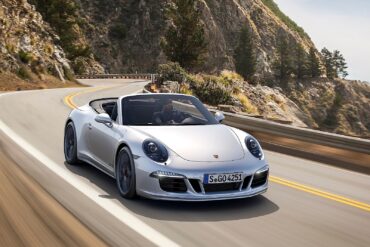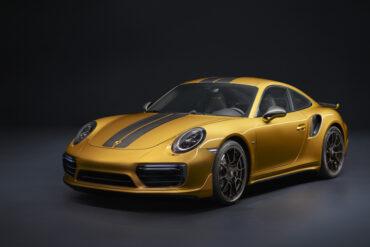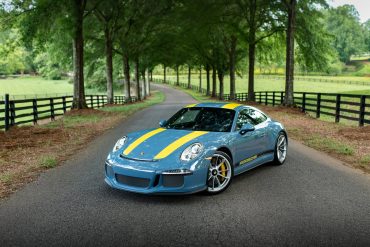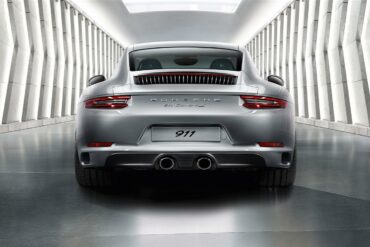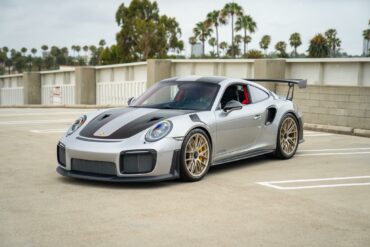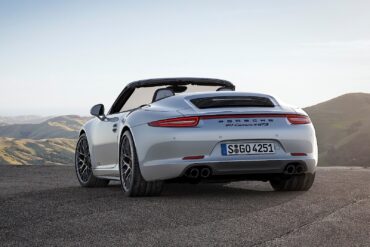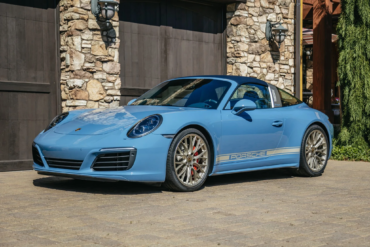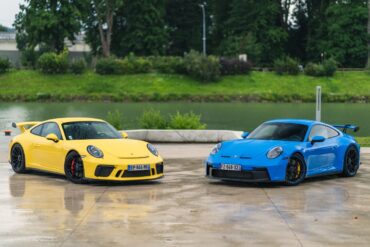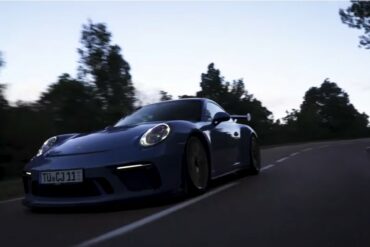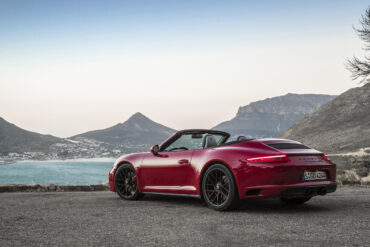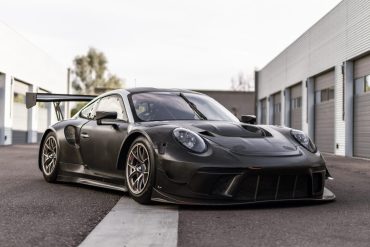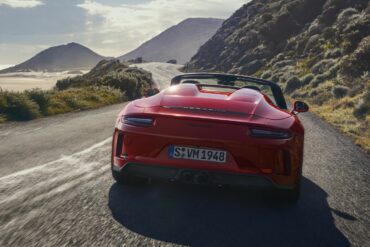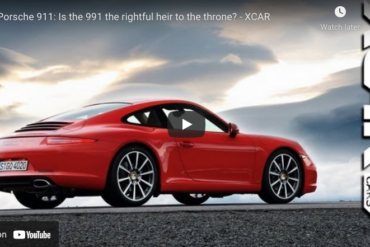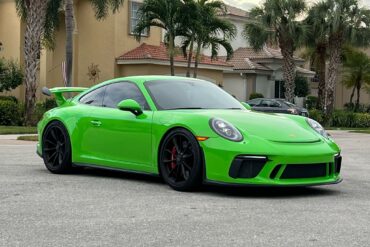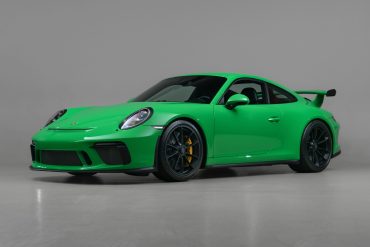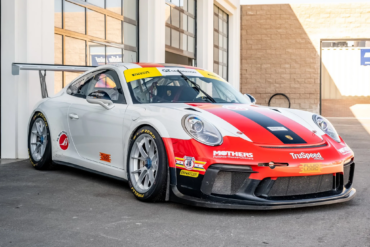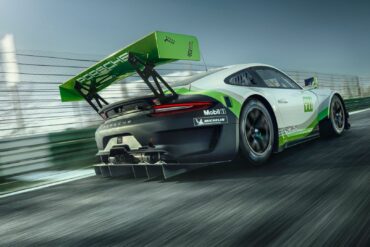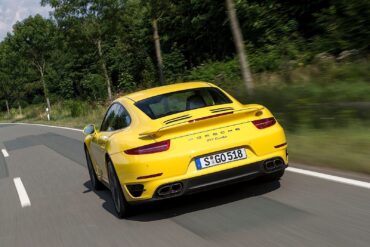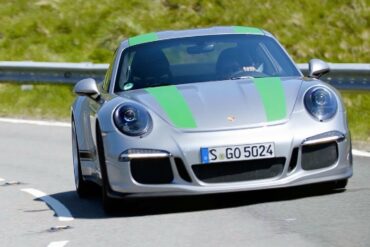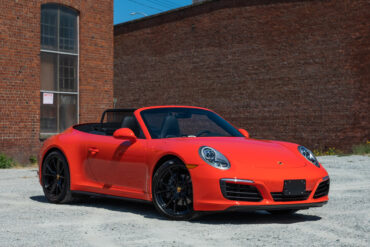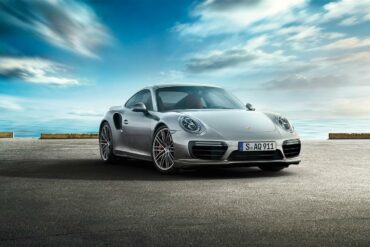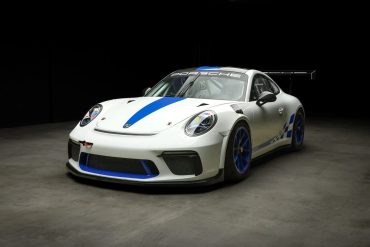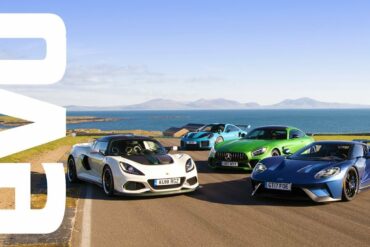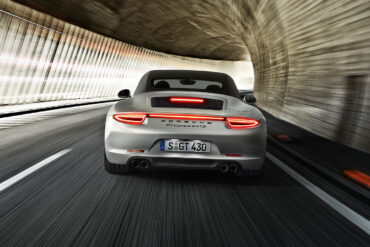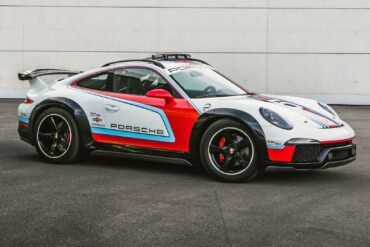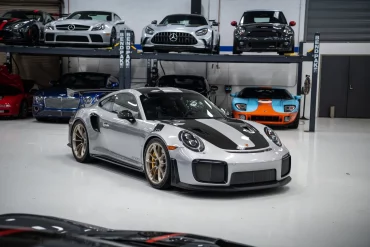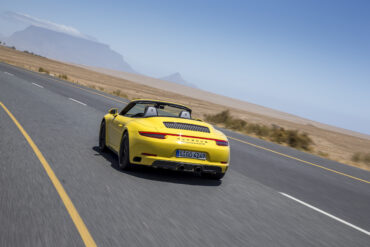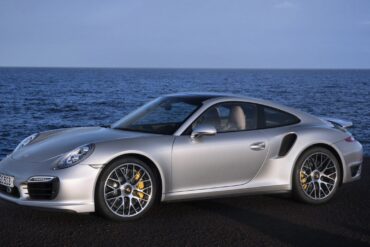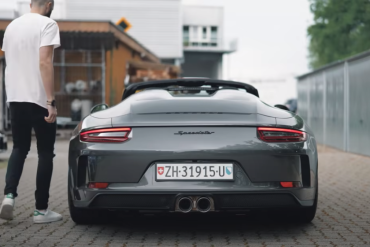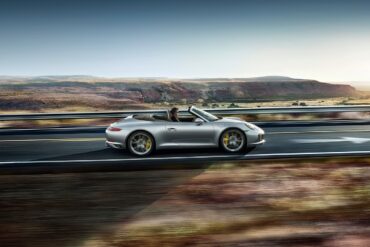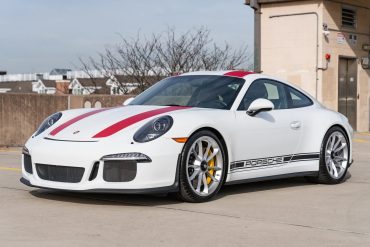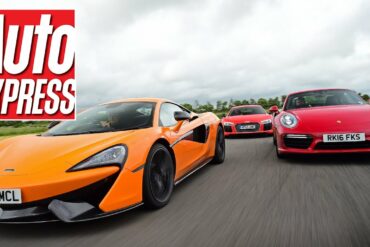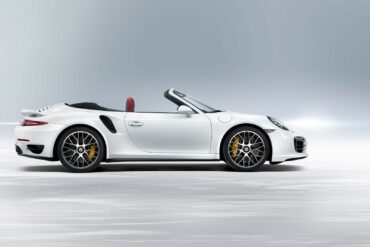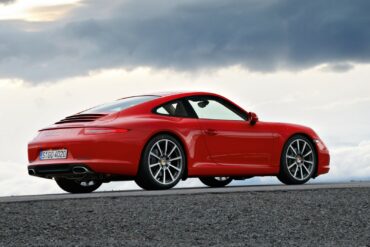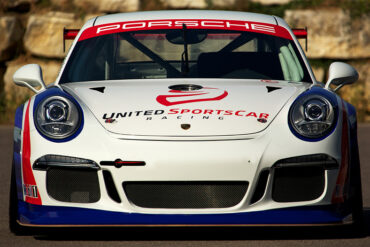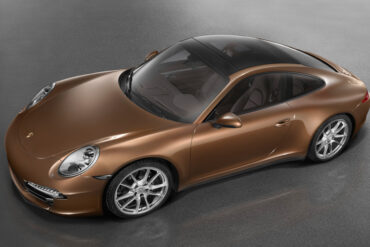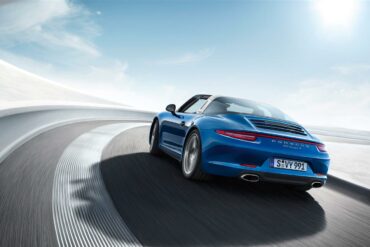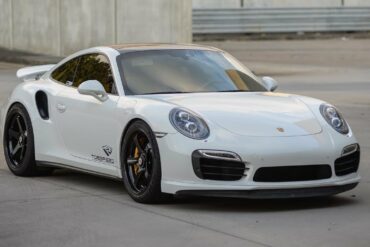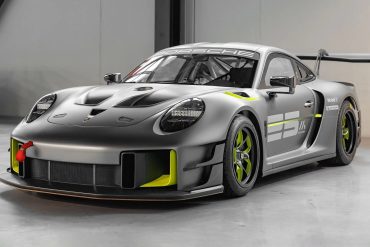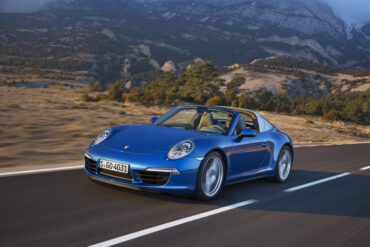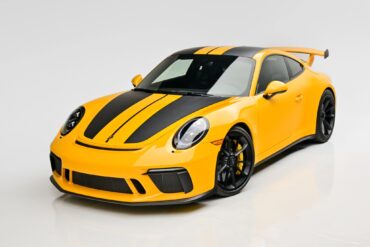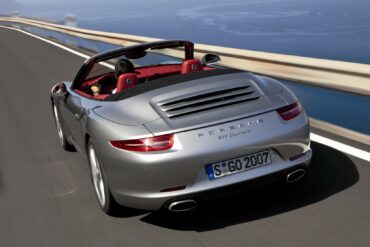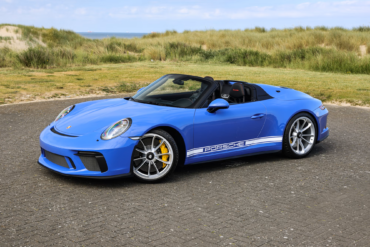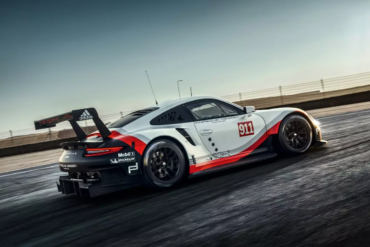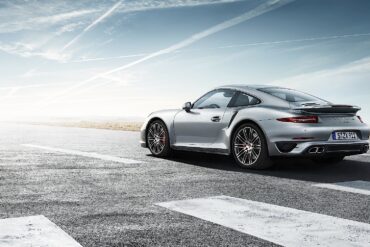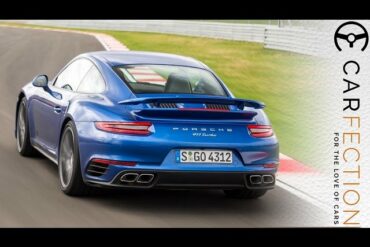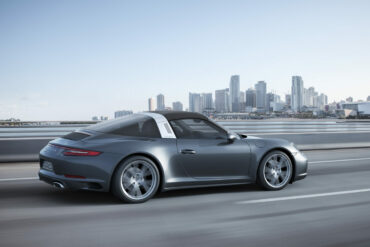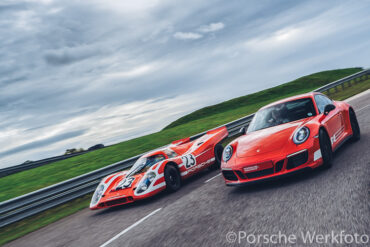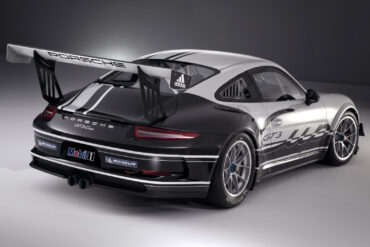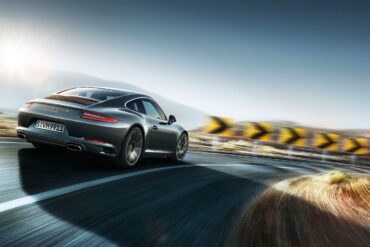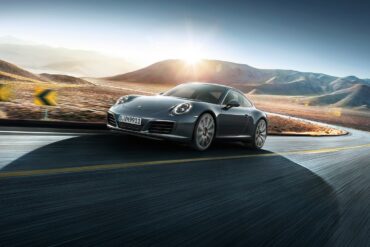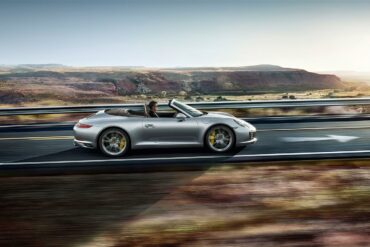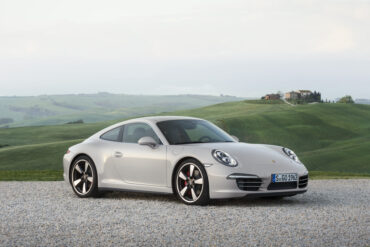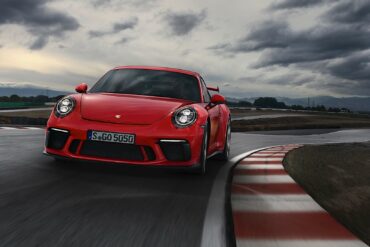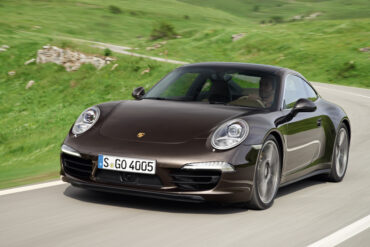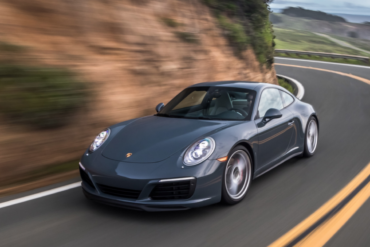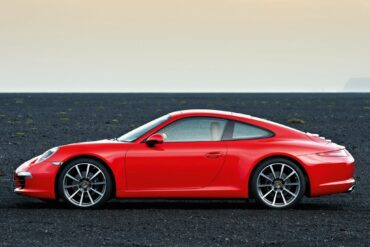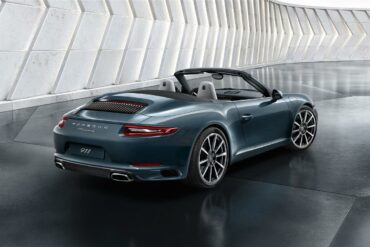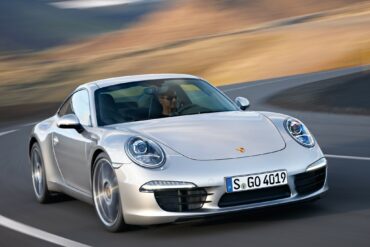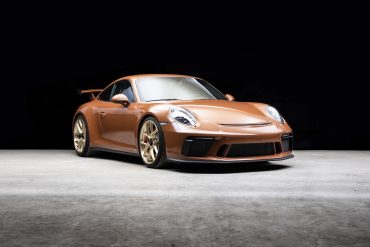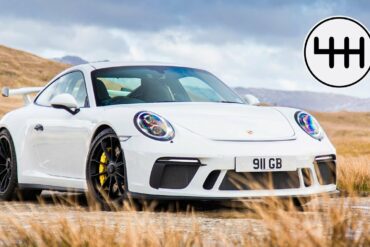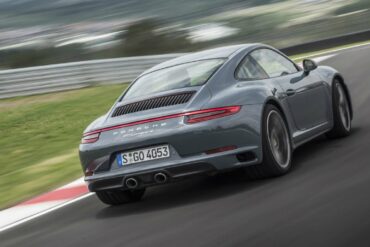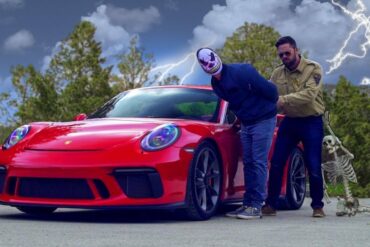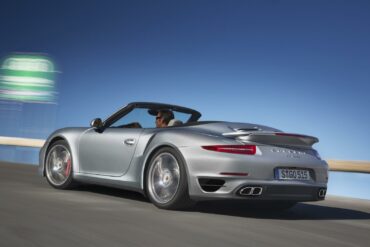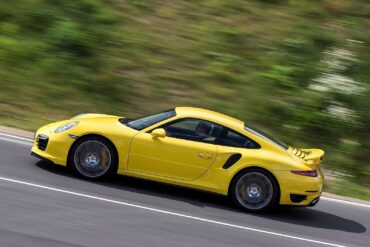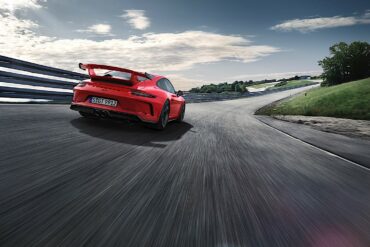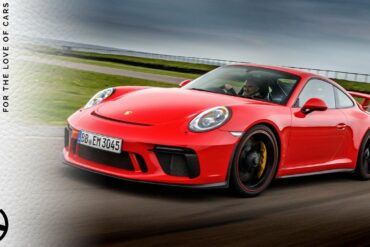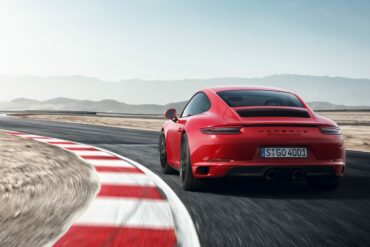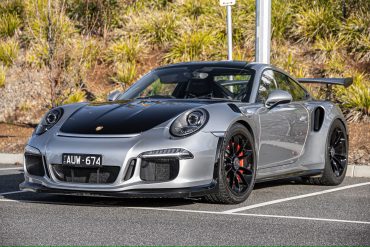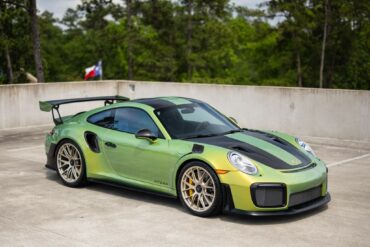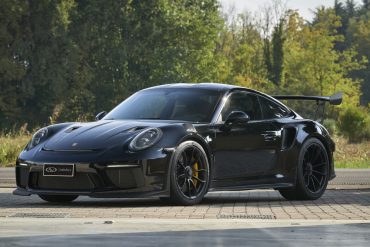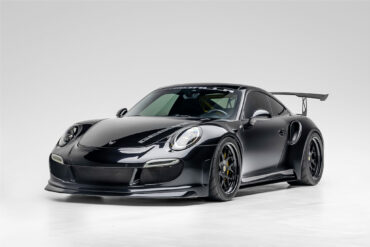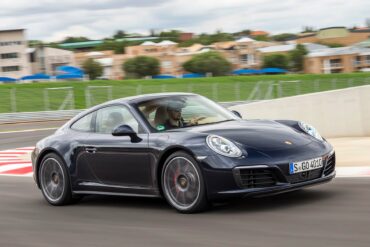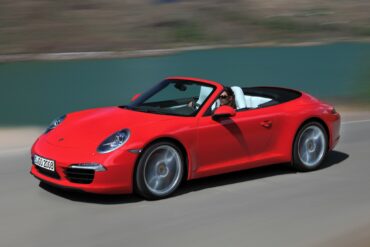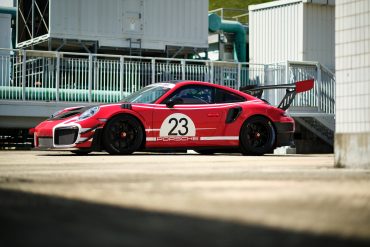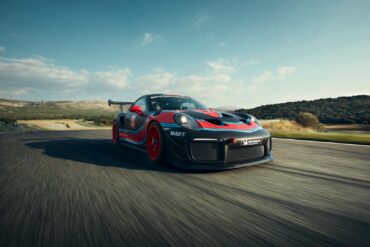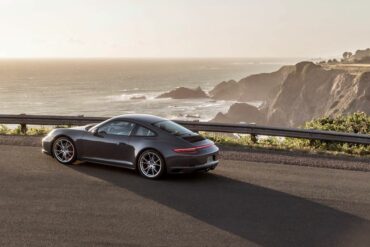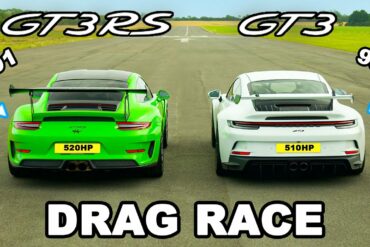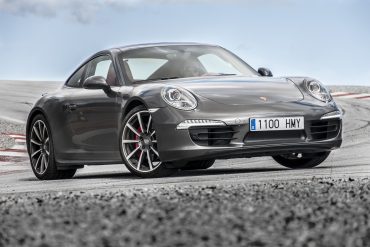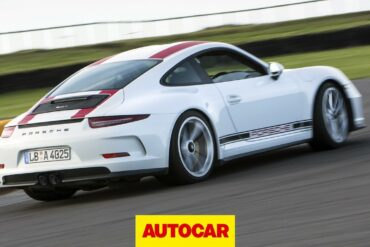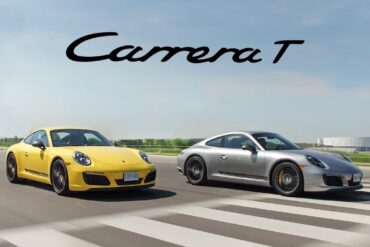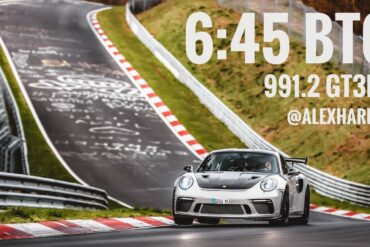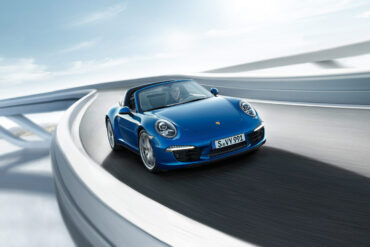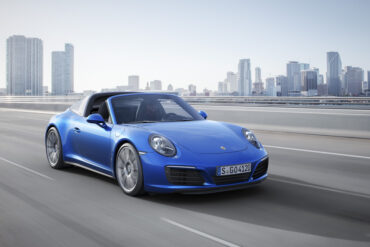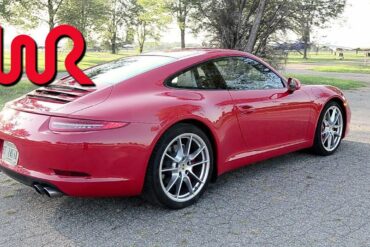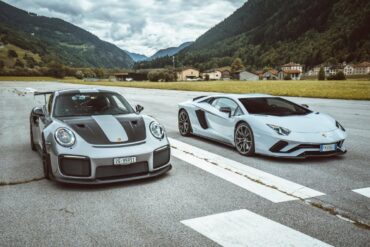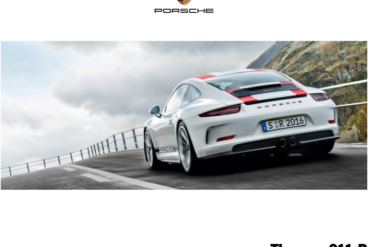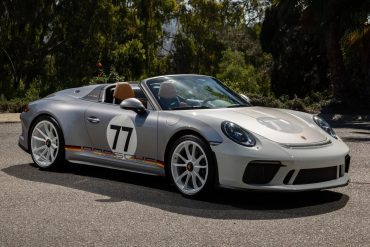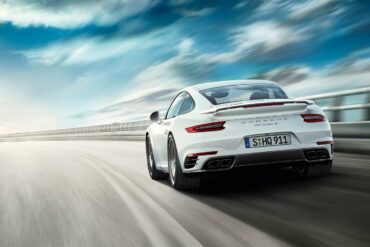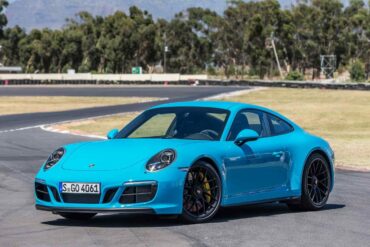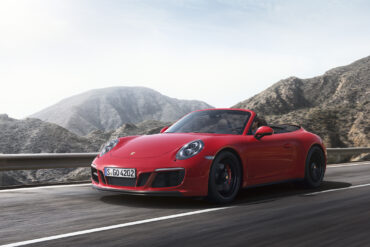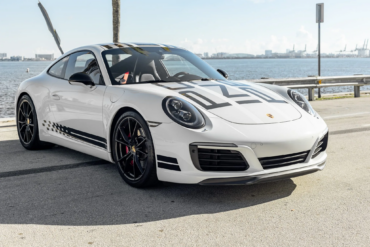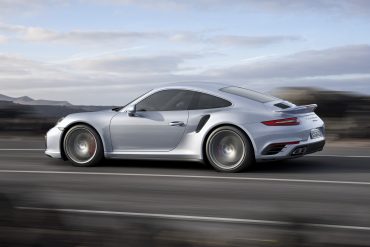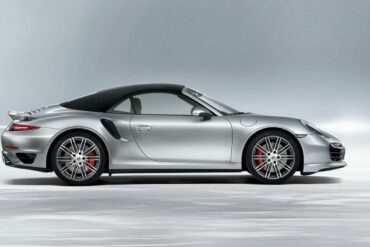So what else do you get when you buy a 991 Carrera 4 GTS Cabriolet? First of all you get a 30 hp bump over the Carrera 4S to 430 hp from the 3.8L naturally aspirated flat-six. You get forged centre-lock black 20-inch wheels, dynamic engine mounts, the Sports Chrono Package, PASM adaptive damping with a lowered ride height, an interior swathed in Alcantara, a sinister front fascia with black intakes and custom rear apron with black tailpipes that broadcast the goods through an uber-nasty sport exhaust system. Other trim details include black lettering and smoked headlights.
Introduced in June 2017, the new 911 Turbo S Exclusive Series is the most powerful all-wheel drive turbocharged member of...
The 2016 Porsche 911 R, despite its limited production, quickly gained popularity among dedicated Porsche collectors and automotive enthusiasts worldwide....
2019 Porsche 911 Carrera S Coupe (991.2) Technical Specifications Engine Engine layout Rear Engine Engine type Boxer, twin-turbo Cylinders 6 Valves...
We’ve got some good news for you, as we’ve found a bargain for a Porsche! Currently, a 2018 Porsche 991...
2015 – 2016 Porsche 911 Carrera 4 GTS Cabriolet (991) Pictures & Gallery ...
This very rare 2017 Porsche 911 Targa 4S currently offered on Bring A Trailer is one of only 24 Exclusive...
Porsche 911 GT3 Buyer’s Guide (991 & 992) Over the past 2 decades, the Porsche 911 GT3 models—and their variants,...
A behind the scenes look of the filming of a Porsche GT3 MR, as they travel towards Corsica to fully...
2017 Porsche 911 Carrera GTS Cabriolet (991.2) Technical Specifications Engine Engine layout Rear Engine Engine type Boxer, twin-turbo Cylinders 6 Valves...
Based on the 911 GT3 RS production sports car, Porsche has designed a customer sport race car for GT3 series...
2019 Porsche 911 Speedster (991) Pictures & Gallery ...
Carfection Reviews the New 991.2 Carrera S A new 911 is always something to pay special attention to. It’s the...
This 991.2-generation Porsche 911 GT3 available for auction on PCarMarket possesses a number of desirable features, chief amongst is its...
The 991.2 generation of Porsche’s 911 GT3 marked a significant improvement over its predecessor, incorporating several desirable changes. Responding to...
From 1990 to 2019, Porsche has already produced over 4,200 units of the 911 GT3 Cup and each of them...
(2019-2020) Porsche 911 GT3 Cup (991.2) Technical Specifications Concept Single-seat customer race car, basis: 911 GT3 RS (991.2) Engine Water-cooled...
2016 Porsche 911 Turbo (991) Technical Specifications Engine layout Rear Engine Engine type Twin Turbo Boxer w/ VTG Cylinders 6 Valves...
Drivers Cars & What Makes Them So Special Chris Harris compares and contrasts the Porsche 911R and the Peugeot 205...
The Carrera 4 Cabriolet gets that wonderful extra-wide body and an AWD system hooked up to its new turbocharged 3.0-liter flat-six engine. Additionally, the Carrera 4 Cabriolet gets a spate of new goodies, including a unique taillight section, and an updated infotainment system that brings the sports car’s connectivity to a whole new level. The open top Carrera 4 does a great job as an all-rounder, giving drivers the all-weather assurance of all-wheel drive and combining it with open top driving fun. Dynamically, it is up there with its coupe sibling.
At the heart of the 991.2 911 Turbo is a twin-turbocharged flat-six with 540 horsepower and 523 pound-feet of torque. That’s a meaningful 20 more horses than the 991.1 Turbo. Improvements that come from increases in boost and fuel-injection pressures. Rounding the skidpad, the Turbo posts 1.02 g’s relatively easily. The wide P Zeros in back and the standard four-wheel steering conspire to hide the fact that 62 percent of the Turbo’s 3656 pounds sits over the rear wheels. With sport-plus selected, the 991.2 Turbo hits a 1.0-second run to 30 mph and a 2.6-second zero-to-60 time.
Built as the second example in a limited production series of only five units for the year 2018, this GT3...
Ultimate Track Test Road Racers. Ford GT, Porsche 911 GT2 RS, AMG GT R and Lotus Exige Cup 430 –...
2016 Porsche 911 Carrera 4 GTS Cabriolet (991) Technical Specifications Engine layout Rear Engine Engine type Boxer-6 Cylinders 6 Valves...
The Porsche 911 Vision Safari a sports car-based rally car concept, designed and built by Porsche in 2012, based on the Porsche 911 (generation 991) and harkening back to the original car, the Porsche 911 SC Safari from 1978. Features a raised suspension, reinforced wheel housings and large bumpers.
The Porsche 911 GT2 RS made its debut during the 997 generation in 2010, receiving immense praise. The 991-generation GT2...
2019 Porsche 911 Carrera 4 GTS Cabriolet (991.2) Technical Specifications Engine Engine layout Rear Engine Engine type Boxer, twin-turbo Cylinders 6...
Porsche Option Codes – Porsche 911 (2014 Model Year) Looking to decode your 2014 Porsche 911 option codes? Want to...
What car and what a sound!...
2016 Porsche 911 Carrera S Cabriolet (991.2) Technical Specifications Engine Engine layout Rear Engine Engine type Boxer, twin-turbo Cylinders 6 Valves...
The 2016 Porsche 911 R, arguably the purest form within the 911 model range, pays homage to the brand’s storied...
Epic Track Battle. Which Is Faster? Since 2012 McLaren’s line-up has ballooned from one car to eight – and one...
2012 RUF RT-35 Anniversary The Rt 35 Anniversary is based on the Porsche 991. Its Turbo power-train is offered only...
2015 Porsche 911 Turbo S Cabriolet (991) Technical Specifications Engine layout Rear Engine Engine type Twin Turbo Boxer w/ VTG Cylinders...
2014 Porsche 911 Carrera Coupe (991) Technical Specifications Engine Type Flat 6 Induction Normally-aspirated Cooling Water-cooled Valvetrain Four overhead camshafts, four...
The Porsche 911 GT3 Touring Is Perfect Does it get much better than this for a supercar that offers so...
2014 Porsche 911 GT America (991) Technical Specifications price $ $269,000 engine Flat-6 position Rear, Longitudinal aspiration Natural ignition Coil-On-Plug...
The 2013 Porsche Carrera 4 featured a 3.4-liter flat-six engine. It was mated as standard to a world's first seven-speed manual transmission. An automatic, PDK (dual-clutch) transmission was offered as an option. The Carrera 4 featured an all-wheel-drive torque distribution in the instrument cluster display. The most distinctive identifying feature of the 911 with all-wheel drive is still the wide rear section: compared to the two-wheel drive 911 Carrera models, the rear wheel housings 22 mm wider, and each of the rear tires is 10 mm wider.
Porsche 911 Turbo S 992 v 991 Head To Head It’s the one you Porsche fanboys have been waiting for...
2015 Porsche 911 Targa 4 (991) Technical Specifications Engine layout Rear engine Engine type 6-cylinder boxer engine Cylinders 6 Valves per...
One Take In An Aftermarket Turbo S This video was filmed at #GRIDLIFE Motorsports and Music Festival South, Road Atlanta....
For all track enthusiasts out there, you might want to check out this year’s Monterey Car Week where a compelling...
For this 991 generation Targa, Porsche went back to the original Targa concept, albeit with an even sexier design and some very cool technical tricks to boot. Porsche wanted to resurrect its classic design, but the company feared that owners would not want to get out of the car, lift off the roof panel, and stow it in the trunk. The other issue was, in the words of 911 product line director Dr. Erhard Mossle, "that the manual solution was a little bit old-fashioned." The 911 Targa 4 gets the same 350 horsepower, 3.4-liter six-cylinder motor as its hardtop siblings.
Live on Bring A Trailer is an exquisite 2019 Porsche 911 GT3, boasting a mere 1,600 miles on its odometer....
2012 – 2015 Porsche 911 Carrera Cabriolet Pictures & Gallery...
The Porsche 991 Speedster is the beneficiary of Stuttgart’s latest fixings, while also serving as a throwback to the Porsche...
(2017-2019) Porsche 911 RSR (991) Technical Specifications Technical data Porsche 911 RSR model year 2017 Concept Single-seater race car for...
Porsche 911 Turbo & Turbo S (991.1) Technical Specs & Performance Here year is year of introduction, not model year....
Carfection Reviews the 911 Turbo S (991.2) The new 911 Turbo S is a very, very fast car. Its predecessor...
2018 Porsche 911 Targa 4 (991.2) Technical Specifications Engine Engine layout Rear Engine Engine type Boxer, twin-turbo Cylinders 6 Valves per...
Porsche is the most successful marque in the 24 Hours of Le Mans and British drivers have played an important role in delivering these historical achievements, and in celebration of this success a special limited edition model – the 911 Carrera 4 GTS British Legends Edition was created. Designed by the drivers who took wins in the 24 Hours of Le Mans for the factory team – Richard Attwood (winner 1970), Derek Bell MBE (winner 1981, 1982, 1986, 1987) and Nick Tandy (winner 2015) – this model was developed by Porsche Cars GB and Porsche Exclusive Manufaktur.
(2013-2016) Porsche 911 GT3 Cup (991.2) Technical Specifications Type Racing Car Built At Stuttgart, Germany Engine Flat-6 Position Rear, Longitudinal...
2016 – 2019 Porsche 911 Carrera (991.2) Pictures & Gallery...
2016 Porsche 911 Carrera Coupe (991.2) Technical Specifications Engine Engine layout Rear Engine Engine type Boxer, twin-turbo Cylinders 6 Valves per...
2016 – 2019 Porsche 911 Carrera S Cabriolet (991.2) Pictures & Gallery...
The 2014 50th Anniversary Edition 911 was built by Porsche to commemorate the 911’s birthday, 50 years after its production launch in 1964. In homage to 1963, the year the 911 debuted at the 1963 Frankfurt Motor Show, production was limited to 1,963 units. The 50th Anniversary uses the wider body from a Carrera 4S (but remains only rear-wheel-drive) and is lower than a standard Carrera by 10mm. The 20 inch-alloys are a modern take on the original Fuchs wheels, and the seats are finished in “Pepita” cloth. Includes Porsche Active Suspension Management (PASM), sports exhaust and powerkit tickled 430 hp flat six.
2018 – 2019 Porsche 911 GT3 (991.2) Pictures & Gallery ...
The new all-wheel drive 911 is being launched on the market in four versions – as the 911 Carrera 4 and 911 Carrera 4S and each as Coupé and Cabriolet. The Coupé and Cabriolet of the 911 Carrera 4 S each have a 3.8-litre rear-mounted boxer engine that produces 400 hp (294 kW); this enables acceleration to 100 km/h in 4.1 seconds (Cabriolet: 4.3 seconds) and a top speed of 299 km/h (Cabriolet: 296 km/h) with a suitable equipment configuration. Fuel consumption values with PDK are 9.1 l/100 km (CO2 215 g/km) for the Coupé and 9.2 l/100 km (CO2 217 g/km) for the Cabriolet.
The new downsized flat-six gets forced induction, more power and greater efficiency, just like in the basic refreshed 911 Carrera, this time mated to a four-wheel-drive system nicked wholesale from the Turbo. Apparently one in three 911 buyers opt for a four-wheel-drive variant, so this is an important car to get right. The 3.0-liter twin-turbo flat-six in the 911 Carrera 4S is good for 414hp and 368 ft lbs of torque, helping it get from 0 to 62 mph in 4.2 sec with a manual, 4.0 seconds with the PDK and 3.6 sec with the PDK and optional Sport Chrono pack.
2012 Porsche 911 Carrera Coupe (991) Technical Specifications Engine Type Flat 6 Induction Normally-aspirated Cooling Water-cooled Valvetrain Four overhead camshafts, four...
2016 – 2019 Porsche 911 Carrera Cabriolet (991.2) Pictures & Gallery...
The 991 Carrera S continued the time honored Porsche 911 tradition of growing in physical size and power. Over the years the 911 has continued its evolution from a pure sports car to a luxurious super-car and the 2012 Carrera S Coupe was no exception. The seventh generation 911 launched in 2012 and it sits on a new platform, with a longer wheelbase and shorter overhangs. It also featured new headlights and taillights. Features a 3.8-liter flat-six engine mated as standard to a world's first seven-speed manual transmission.
Porsche’s 911 GT3 of the 991.2 generation incorporated several improvements over its predecessor. Responding to the demands of its loyal...
Carfection Makes The Case for the Manual Henry Catchpole demonstrates why the manual is something to be treasured in a...
2016 Porsche 911 Carrera 4 Coupe (991.2) Technical Specifications Engine layout Rear Engine Engine type Boxer, twin-turbo Cylinders 6 Valves per...
Make no mistake that the Speedster is an absolutely fitting conclusion to the 991-generation. The Porsche 911 Speedster is an ingenious amalgamation of the latest technologies on offer, and the more simple ingredients that have been a principle of driving enjoyment since the invention of automobiles. A 502-horsepower engine, without turbochargers. A modern transmission, with just one clutch. A state-of-the-art suspension and chassis, with an unsullied purity. The list goes on. Perhaps the only drawback is that the Speedster’s rarity and price.
Porsche 911 GT3 (991.2) Manual Fun On this Special episode James and Thomas take a spin in the legendary Porsche...
2014 – 2016 Porsche 911 Turbo Cabriolet (991) Pictures & Gallery ...
2014 Porsche 911 Turbo (991) Technical Specifications Engine layout Rear Engine Engine type Twin Turbo Boxer w/ VTG Cylinders 6 Valves...
2019 Porsche 911 GT3 (991.2) Technical Specifications Engine Engine Type Aluminium horizontally opposed and naturally aspirated engine Cylinders 6 Displacement 3,996...
2018 Porsche 911 GT3 Track Review Porsche have listened to their customers and added all the lessons they’ve learned recently...
2019 Porsche 911 Carrera GTS (991.2) Technical Specifications Engine Engine layout Rear Engine Engine type Boxer, twin-turbo Cylinders 6 Valves per...
The 911 GT3 RS represents the pinnacle of Porsche’s fusion of race and road car technology, designed to meet FIA...
Live now on PCARMARKET is a 2019 Porsche 911 GT2 RS with a stunning one-of-a-kind Python Green Chromaflair exterior finish...
When automotive enthusiasts are asked to describe the pinnacle of the Porsche 911, the GT3 RS overwhelmingly dominates the conversation....
This 2015 Porsche 991 Turbo S received a full Stage 4 Gemballa upgrade including an enlarged 4.0L engine with forged...
Thought it carries a similar design to the new 911, the Carrera 4 has its own unique features, the most obvious being an AWD system hooked up to its new turbocharged 3.0-liter flat-six engine. The C4 gets a spate of new goodies, including a unique taillight section, and an updated infotainment system that brings the sports car’s connectivity to a whole new level. Inside the new 911 Carrera 4, there are only a few changes, the most important is the new infotainment system. With 370 hp on tap from the direct-injection, twin-turbo flat-six and all-wheel drive putting all those ponies to the ground, the C4 is more than quick enough.
2012 Porsche 911 Carrera S Cabriolet (991) Technical Specifications Engine Type Flat 6 Induction Normally-aspirated Cooling Water-cooled Valvetrain Four overhead camshafts,...
Introduced alongside the 992-generation 911 at the 2018 Los Angeles Auto Show, the 911 GT2 RS Clubsport marked the culmination...
2018-2019 Porsche 911 GT2 RS Clubsport Race Version Pictures & Gallery...
2016 Porsche 911 Carrera 4S (991.2) Technical Specifications Engine layout Rear Engine Engine type Boxer, twin-turbo Cylinders 6 Valves per cylinder...
Two of our favorites duke it out...
Porsche Option Codes – Porsche 911 (2013 Model Year) Looking to decode your 2013 Porsche 911 option codes? Want to...
The Porsche 911 R On Track The phenomenal Porsche 911 R stars in our penultimate video from Britain’s Best Driver’s...
Reviewing The Purist Porsche We go for a drive in the 2018 Porsche 911 Carrera T Manual and PDK....
Watch as a 991.2 Porsche 911 GT3 RS (driven by Alex Hardt) completes a full lap around Nordschleife of the...
2014 – 2015 Porsche 911 Targa 4 Pictures & Gallery ...
2016 Porsche 911 Targa 4 (991.2) Technical Specifications Engine Engine layout Rear Engine Engine type Boxer, twin-turbo Cylinders 6 Valves per...
A stock Porsche 911 Turbo S, particularly from the 991-generation, is already an impressive vehicle. With a 560-horsepower 3.8L twin-turbo...
The 991.2 911 Targa 4S is powered by the latest water-cooled 3.0-liter twin-turbocharged flat-six from Porsche, producing 420 hp and 368 lb-ft of torque. It can be optioned with a PDK seven-speed dual-clutch automatic (a seven-speed manual is standard) and all-wheel drive is standard. Whereas the two earlier generations of Targas were little more than 911 Carreras with large glass sunroofs, the 991-series Targa nailed the look and feel of the original.
2013 Porsche 911 Carrera S Coupe – WINDING ROAD POV Test Drive Great POV review of the 991.1 Carrera S....
Porsche GT2 RS vs Lamborghini Aventador S! The title says it all. Just two friends drag racing two amazing cars...
Porsche 911 Sales Brochures (Type 991) We found quite a few Porsche sales brochures for the Type 991 911 generation....
The 2019 Porsche 911 Speedster inherits Stuttgart’s latest advancements while paying homage to the original Porsche 356 Speedster. This design...
2018 Porsche 911 Turbo S (991.2) Technical Specifications Engine Engine layout Rear Engine Engine type Boxer, twin-turbo Cylinders 6 Valves per...
2017 – 2019 Porsche 911 Carrera GTS (991.2) Pictures & Gallery...
The GTS 4 Cabriolet reminds us how awesome Porsche cars are. This is a 911 that can be used as a regular car, an all weather convertible 911 that does everything really well. And when you want to push hard, the car transforms into a true sports car, a car that no enthusiast will ever complain about. Drop-top 911s have always played a supporting role to the fixed roof versions, but in GTS specification the Cabriolet is now better than ever.
Designed and manufactured by Porsche Exclusive, also known as the ‘Special Wishes Department’, this department of the factory is dedicated...
2017 – 2019 Porsche 911 Turbo (991.2) Pictures & Gallery ...
2014 Porsche 911 Turbo Cabriolet (991) Technical Specifications Engine layout Rear Engine Engine type Twin Turbo Boxer w/ VTG Cylinders 6...


